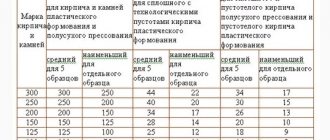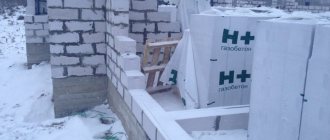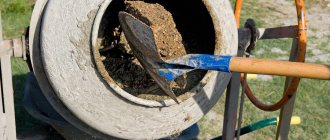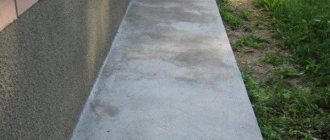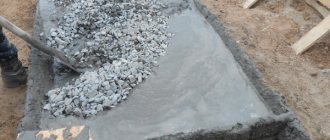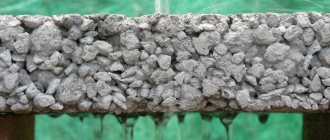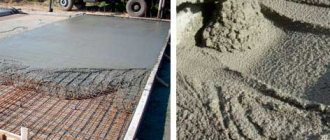This is one of the most important regulatory indicators of concrete in the construction industry, affecting the operational reliability and durability of products. It characterizes the ability of a hardened material, after repeated freezing and thawing, not to lose its strength characteristics by more than 5% for heavy concrete, and no more than 15% for cellular concrete.
As you know, to check technical indicators, control cubes of concrete mixture measuring 100 mm X 100 mm X 100 mm are poured. These samples are subjected to frost resistance tests after 28 days of hardening. It must be said that frost resistance can only be measured in laboratory conditions. Let's find out how the tests are carried out.
GOST 10060 – 2012 Concrete. Methods for determining frost resistance
The test cubes must be placed in aqueous or slightly alkaline solutions for a certain time.
Remove from the water or solution, allow to dry and place in the freezer. The temperature in the chamber is set to -18C and maintained for 3 hours.
Then the samples are placed in another chamber, in which the temperature is +20C and the samples are kept for 3 hours at this temperature.
Thus, one cycle of freezing and thawing is performed. If the design documentation specifies a concrete grade for frost resistance, which is designated F 100, for example, this means that laboratory samples of these concretes must withstand 100 cycles of alternating thawing and freezing and, after all tests, not lose more than 5% of the control samples in strength and weight .
Moreover, they should not have any visible damage to the surface, such as chips, cracks or peeling on the edges of the samples.
After carrying out the designed tests for frost resistance, the samples are subjected to a compression test.
Each batch contains 6 control and 12 test cubes. After checking the strength indicators, the results are processed using a combination of a number of formulas; we will not consider them in this article.
Let us only note once again that the tests are considered successful only if the deviation of the compression indicator of the tested cubes in the average statistical value does not exceed 5% of the strength of the control cubes.
Types of assessment and control
To be able to be used in construction, concrete must meet many parameters. These include: resistance to low temperatures, water resistance, strength, resistance to deformation and much more. To determine certain characteristics, as part of the examination, they resort to a variety of tests, which can be carried out both in laboratory conditions and on the construction site. Methods are divided into two main types:
- destructive (drilling, separation, etc.);
- non-destructive (ultrasound testing, so-called elastic rebound, etc.).
Construction and technical characteristics, as well as the methods used to determine them, are recorded in numerous GOSTs. The research results are recorded in the so-called test report, on the basis of which a conclusion is issued on the properties of concrete and its suitability for certain purposes.
If we talk about the examination, which is carried out at the design stage using a destructive method, then this includes a lot of laboratory research. The main ones include:
- determination of frost resistance;
- water resistance research;
- determination of compressive strength;
- workability research and many others.
As part of the inspections, professional equipment is used, and conditions are created that are as close as possible to those that accompany concrete during its operation. Laboratory tests are carried out using samples of various weights and sizes. A separate methodology is used for each of the research parameters.
Concrete grades by frost resistance
Graduated F 25, F 35….. F 800, F 1000. A total of 13 classes.
It should be noted that the frost resistance grade does not indicate the number of winters that the concrete in these structures will withstand, not at all. After all, in winter the temperature crosses the zero line not just once, but many times. These quantities do not have such a direct relationship.
But where there is a dependence is in the strength indicators of concrete. The higher the grade of concrete, the higher the frost resistance should be. Here is the dependency table:
| Concrete grade | Concrete class | Frost resistance F |
| M100, M150 | V-7.5, V-12.5 | F50 |
| M200, M250 | V-15, V-20 | F100 |
| M300, M350 | V-22.5, V-25 | F200 |
| M400 | B-30 | F300 |
| M450, M550, M600 | V-35, V-40, V-45 | F200-F300 |
There are basic test methods, second and third. Their difference is in the solutions they contain. So, in the basic method, an aqueous solution. In the 2nd and 3rd – 5% sodium chloride solution.
But in the 3rd, an increased temperature of up to -55C is also used. These tests apply only to concrete road and airfield pavements.
Today there is a device called “Measuring complex for accelerated measurement of frost resistance of concrete Concrete - Frost”.
This device allows you to obtain a series of frost resistance indicators in a short time. The video below says nothing about the legality of applying these results. Therefore, it can be assumed that its results are used for self-testing in concrete plants.
Independent laboratories most likely do not use such devices in their practice, but are required to use the methods prescribed in GOST.
Water permeability
The structure of concrete structures has pores and capillaries. The higher the open porosity, the greater the water permeability. For aerated concrete it reaches 25%. Dense structural concrete has the lowest water permeability. The class is designated by the letter “W”.
In order to increase moisture resistance and frost resistance, plasticizers and modifiers are additionally used.
Classification of concrete according to strength class, frost resistance, water permeability (table):
Water resistance (W)М100В7,5W2М150В12,5W2М200В15W4М250В20W4М300В22,5W6М350В25W8М400В30W10М450В35W8-W14М550В40W10-W16М600В45W12-W18What affects the frost resistance of concrete?
Our native water-cement ratio. This is an indicator of the ratio of the mass of water to the mass of cement (W/C). The higher this indicator, the more water in the concrete mass will not react with the cement clinker.
Of course, it will evaporate over time, but the remaining excess water will have a negative effect.
As you know, when water freezes, it expands in volume, turning into ice. The expansion coefficient is 1.09.
Thus, increasing in volume by 9%, water puts pressure on the concrete from the inside and destroys it, which naturally reduces frost resistance.
Water absorption
Paradoxical as it may seem, concrete in the design strength indicator, when in contact with water, absorbs water in addition to the water already present inside, which has not reacted with the cement clinker. The surface layers will take up water especially actively. The absorbed water is subject to the effect of the thermal expansion process already described above. And as a result - a drop in the frost resistance grade.
Porosity of concrete
There is a theory that small pores filled with air dampen the pressure of ice crystals formed as a result of freezing and thereby reduce the loss of the destructive effect. This theory has been confirmed in practice.
Porosity of aggregates
If the filler has a porous macrostructure, then again, as in the well-known effect, water accumulates and it freezes and causes expansion of the concrete structure and, as a result, a decrease in frost resistance. When using dolomite aggregates or crushed limestone rocks, it is almost impossible to achieve a high frost resistance.
Concrete grade
Yes, it is the strength indicators, in other words, the brand of cement used that significantly affects the final frost resistance. And as you know, the grade of concrete is directly related to the W/C (see point 1).
Steaming concrete and reinforced concrete structures. During this process, fine-porous structures are destroyed and relatively large capillaries are formed, which, as is generally accepted, do not contribute to increasing frost resistance.
Determination of water resistance
To calculate this parameter, cylindrical samples with a height of 15 cm are most often taken. The workpieces are subjected to pressure under laboratory conditions, which occurs under water pressure. This method is called “wet spot”. Six cylindrical blanks are fixed in a special UVF-6 installation for at least 16 hours, during which water pressure is applied within 0.2 MPa. For the next 16 hours, the exposure threshold increases. Such manipulations continue until liquid begins to seep through the samples.
After this, measurements and calculations are carried out. The results of water resistance tests are determined in the ratio kg/cm3 of the product. Such studies are regulated by GOST 12730.5-84. As a result, concrete is assigned a certain grade of water resistance. It is designated by the letter W. The higher the water pressure at which the seal is maintained, the greater the water resistance grade.
For such studies, cubes with an edge of 15 cm can also be used. In this case, their air permeability is measured using an “AGAMA-2R” type device. This is an accelerated method in which equipment measures how long it takes for gas to penetrate the product. The use of this method, taking into account the existing discrepancies in the results obtained, is advisable for concrete of low and medium grades of water resistance.
When using each method, an important condition is the absence of chips and cracks on the samples being studied.
How to increase the frost resistance of concrete
The minds of many scientists today are occupied with this super task. It is considered an important indicator that has a great influence on frost resistance not only the overall porosity of the cement stone, but also the size of these pores.
Scientists through research have come to the conclusion that micropores even help increase frost resistance, because water at a temperature of 0 -1 C begins to turn into ice and expands without disturbing the structure of the cement stone in these pores. Micropores seem to dampen the stretching effect.
What tricks do builders resort to in pursuit of high frost resistance:
Reduced water-cement ratio
The optimal W/C is considered to be 0.4 -0.5; at this ratio, the formation of a capillary structure of cement stone does not occur.
Of course, it is completely impossible to avoid porosity, but it is believed that these small pores are filled with water in a gel state, i.e. pseudo-hard, and are not subject to the expansion effect when moving to sub-zero temperatures.
Gel formations are formed before the onset of frost, therefore, the longer the hardening period of the cement stone before the appearance of sub-zero temperatures, the higher the frost resistance of concrete.
Application of plasticizing additives
Such as SSB (sulfite-alcohol stillage), SDB (sulfite-yeast brew), S-3. These plasticizers make it possible to increase the workability of the concrete mixture and, therefore, make it possible to increase the W/C to a value of 0.4-0.45, which, as we have already noted, has a positive effect on increasing frost resistance.
Application of air-entraining additives
As we have already discussed, the fine porosity of concrete stone increases frost resistance, which is why additives of this kind are used.
These additives can be petroleum products, vegetable fats, soap and many others. The dosages of these additives are related to the weight of the cement and they are very small up to 0.02%.
Introduction of organosilicon compounds into concrete mixtures
These are polyhydroxyloxanes and sodium silicates (GKZh-94, GKZh-13, GKZh-10). A chemical reaction occurs between these substances and the cement hydration products with the release of hydrogen and new complex formations.
They are insoluble in water and fill the capillary structures and pores of cement stone, thereby hydrophobizing the surfaces of concrete structures.
The hydrophobization process increases the water resistance of concrete, thereby improving frost resistance. The amount of additives is 0.1-0.2% by weight of cement.
Scope of application depending on classification
The frost resistance class is indicated by a set of letters and numbers. GOST identifies five such classes:
- Below F50 (low). At subzero temperatures, this concrete becomes covered with cracks and begins to crumble. In the climatic conditions of Russia, such material is almost never used.
- F50 – F100 (moderate). A fairly common frost resistance class. Concrete of this class is used on construction sites in all regions of the Russian Federation, where the four seasons are clearly separated.
- F150 – F300 (increased). Concrete is used in harsh climates with large temperature changes. In extreme conditions it is able to fully maintain its original quality. It is used on construction sites in the northern regions of Russia and Siberia.
- F300 – F500 (high). Designed for special occasions. Suitable for areas with significant soil freezing, areas with cyclical rises in groundwater levels.
- Above F500 (extra high). Isolated cases of application for particularly critical structures.
Briefly about the main thing
- The frost resistance of concrete structures directly affects their durability, especially hydraulic, road, and irrigation structures.
- The processes of alternating freezing and thawing lead to the expansion of water in the concrete mass and, when turning into ice, an increase in volume by approximately 10%. This effect breaks the walls of capillaries and pores of cement stone and aggregates and reduces the strength of the structure.
- To avoid lengthy and expensive procedures for testing concrete samples for frost resistance, complexes of instruments from the Interpribor company are used, which make it possible to quickly determine frost resistance in accordance with GOST 10060-2012.
- In order not to worry about obtaining the necessary frost resistance, take a concrete mixture of a higher grade and this will certainly lead to its increase.
- Concrete mixtures based on dense aggregates, for example, granite crushed stone, will certainly have increased frost resistance.
- To pour concrete in cold weather, use antifreeze additives that prevent the water in the mixture from crystallizing and turning into ice. Being in a liquid state, water participates in the hydration reaction of cement and strength gains occur during frost. There are additives that allow you to work at -30C. But then it is necessary to add additives that accelerate the hardening of cement.
Increased frost resistance
The frost resistance of concrete is ensured by several factors: the size and number of pores, tensile strength, composition and the presence of additives. Several techniques are used to increase quality:
- Reducing moisture in the material by using uncontaminated fillers, as well as special additives.
- Reduced macroporosity. To do this, it is necessary to create conditions for rapid hardening of the solution, and use additives that reduce the need for the water component.
- Freezing concrete at a later age will reduce the degree of porosity.
- Insulation. Sometimes it is easier to protect the material from adverse conditions. There are specialized paints and impregnations that increase the service life of concrete products.
- Addition of chemical additives (solutions of nitric, carbonic and hydrochloric acids). Special additives help increase the number of small pores into which water cannot penetrate. Additives are introduced using heating methods. The proportions of additives must be observed according to the instructions, otherwise there is a risk of only worsening the properties of concrete.
